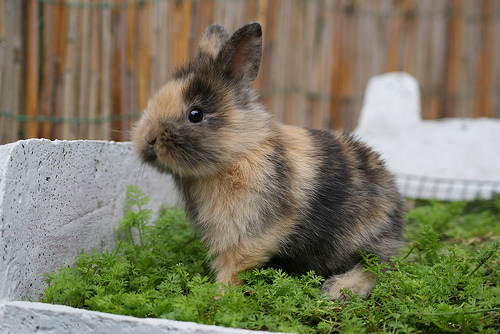
Dental problems are one of the most commonly diagnosed problems in rabbits. A better understanding of the causes of dental disease can help owners prevent or treat disease in their rabbits.
How do rabbits teeth differ from other animals?
Rabbits are grazers, with teeth designed for grinding high fibre food throughout the day. They have six incisors, four upper and two below, that function to cut or shear food. Rabbits also have six cheek teeth on either side which are used for grinding fibrous material. Unlike a human’s teeth, a rabbit’s teeth will continue growing throughout its life.
The constant act of eating wears down the rabbit’s teeth, preventing overgrowth.
Can I clip my rabbit’s teeth to prevent them from overgrowth?
Clipping is a frequent source of trauma to rabbits’ teeth. Using incorrect equipment such as dog nail clippers for teeth trimming can cause the teeth to shatter or to loosen them. Trimming can be safely accomplished by a veterinarian using a dental burr.
Why do rabbits get dental disease?
The dental problems seen in rabbits are usually caused by malocclusion (teeth do not align correctly) and overgrowth of teeth. The source of their dental disease may be due to a number of factors:
1. Diet: this is probably the primary cause or a contributing cause to every case of dental disease. High-fibre diets are essential to wearing down teeth. Commercial pelleted foods are low in fibre, and high in fats and carbohydrates. Lack of calcium can also lead to bone resorption and tooth loosening.
2. Congenital Deformity: Breeding has resulted in anatomical changes in rabbits. The most common example of this is mandibular prognathism (shortening of the jaw so that the incisors do not meet) in many dwarf breeds.
Malocclusion of the incisors prevents them from being worn down, allowing overgrowth at a rate of a couple of millimetres a week to occur – once overgrowth begins, eating becomes impossible. Mandibular prognathism is thought to be inherited, so affected animals should not be bred.
3. Trauma to the teeth or jaw: Rabbits can easily damage their teeth by gnawing on the bars of their cage, falling (or being dropped) from a great height, or by tooth clipping.
4. Infection of the tooth roots: this is uncommon as a primary cause of dental disease. Infection usually occurs after prolonged dental disease.
What are the signs that my rabbit may have problem with its teeth?
The signs of dental disease may not always be apparent in the early stages of disease. However, as the problem worsens, any of the following symptoms may be evident:
• Excessive salivation (“slobbers”) – due to pain or inability to shut the mouth
• Anorexia (loss of appetite) – can be caused by inability to eat due to maloccluded teeth, or pain from sharp overgrowths that lead to cuts and ulcer formation on the tongue and cheeks
• Selective feeding – rabbits with tooth pain may seek out softer foods
• Dropping food – pain or difficulty eating causes the rabbit to drop food out of its mouth when attempting to eat
• Weight loss – following anorexia
• Lip lacerations – due to sharp overgrowths of the teeth
• Excessive production of tears – associated with blockage of the tear duct by overgrown tooth roots
• Nasal discharge – tooth root infections can result in drainage into the sinuses, which then drain into the nasal passages
• Bulging of the eye – due to abscess formation behind the eye
If your pet is showing any of these signs, an appointment should be made with a veterinarian. Dental disease has a better prognosis if the rabbit is treated in the early stages of disease.
How does the veterinarian diagnose dental disease?
Your pet’s teeth should be examined at least once a year by a veterinarian. The veterinarian will diagnose dental disease based on any relevant history (such as the signs listed above), and a thorough physical exam. The rabbit’s jaws are palpated for bumps and swelling, and moved from side to side to check for normal movement.
The vet should always look inside your rabbit’s mouth, even at routine check-ups! Your rabbit may need to be sedated for the vet to perform the oral exam, or for x-rays of the skull to be taken. X-rays allow visualization of the tooth roots and will show any signs of osteomyelitis (infection of the bone).
How is the dental disease treated?
Most rabbits will have to be sedated or anaesthetized to have their teeth professionally trimmed by a veterinarian with a dental burr. The veterinarian will smooth down any painful overgrowths and may remove teeth as well. A course of antibiotics will be prescribed if infection is present.
Myth#1 – My rabbit won’t be able to eat if its incisors are extracted.
Extraction of incisors is a common procedure. Maloccluded incisors are no longer functional, and often serve as an impediment to feeding. Rabbits can still prehend food using their lips. Your rabbit can still be fed its normal diet, although larger items like carrots should be grated first.
Also, since the rabbit uses its incisors to aid in grooming, owners should groom their pets regularly.
Myth#2 – Once my rabbit has had his teeth trimmed, it won’t require any further treatment.
Unfortunately, dental disease frequently recurs, and thus regular dental examinations are usually required.
How can I prevent dental disease?
Successful prevention relies on feeding the correct diet. Increase fibre intake (grass is about 25% fibre) and reduce intake of pelleted feeds. An appropriate rabbit diet is: ad lib hay and or grass, a maximum of 25g per kg of bodyweight/day of a high fibre pellet, and a pile of leafy green vegetables the size of the rabbit’s head twice a day.
(photo: jpockele)